“IT’S SUNDAAAY!!! ” This afternoon, we played laser tag at home – and what a great day!’ During school days, it was a regular weekend expression; now, it has been shifted to vacation or celebration days.
Yes, laser tag is not all about playing in the arenas; we often arrange parties at our house to have fun with family and friends without any age barriers. Even my granny sometimes joins us while making barbeque for the evening.
It all started around 10 years ago when I was still studying in school. During a rainy day, we had to cancel the arena event and were forced to play in the backyard of our residence. Although I missed the ambiance of the arena, I started to enjoy home-based laser tag gradually.
In this blog post, I’ll be discussing how to set up and play lasergame at home, including the equipment needed, how to create a playing area and the rules of the quest.
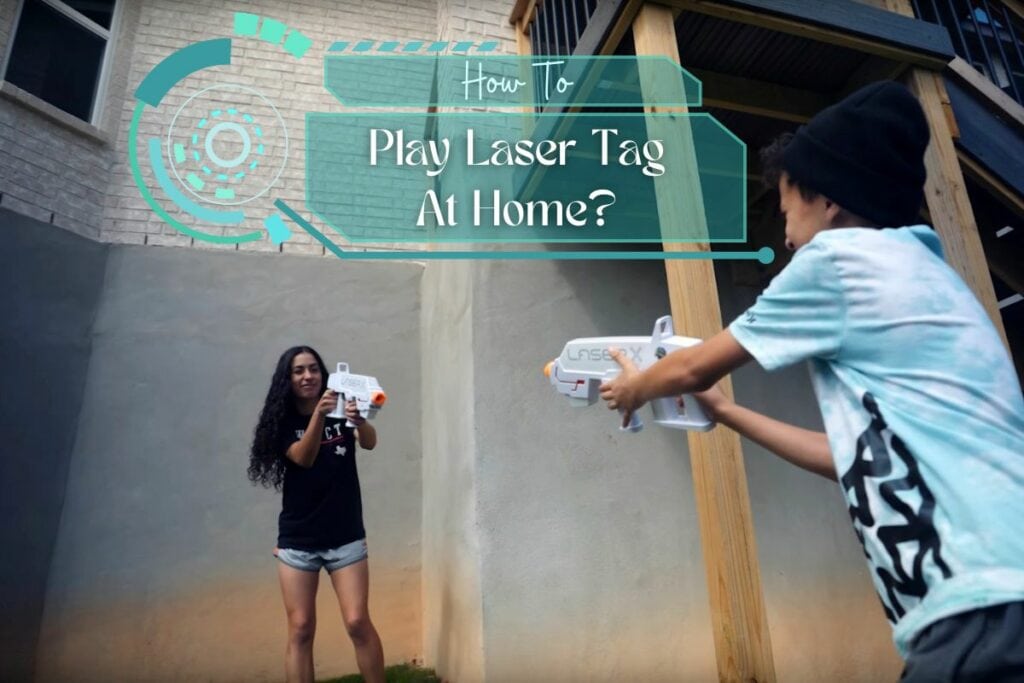
How To Play Laser Tag At Home?
As a professional player with over a decade of experience under my belt, I’m excited to share with you a step-by-step guide on how to play laser tag at your home. Whether you’re a beginner or an experienced player, these tips will help you to create a thrilling experience for you, your family, and your friends.
Step 1: Acquire Laser Tag Sets
To play at your house, you’ll need guns and vests for each player. There are various brands and types available, so choose the best home laser tag set that fits your budget and preferences.
I personally recommend the brands Squad Hero, Armogear, Laser X, and Kidzlane. Those offer multiple weapon options, such as pistols, automatic, laser, and rocket, as well as adjustable hit points to create a more immersive experience.
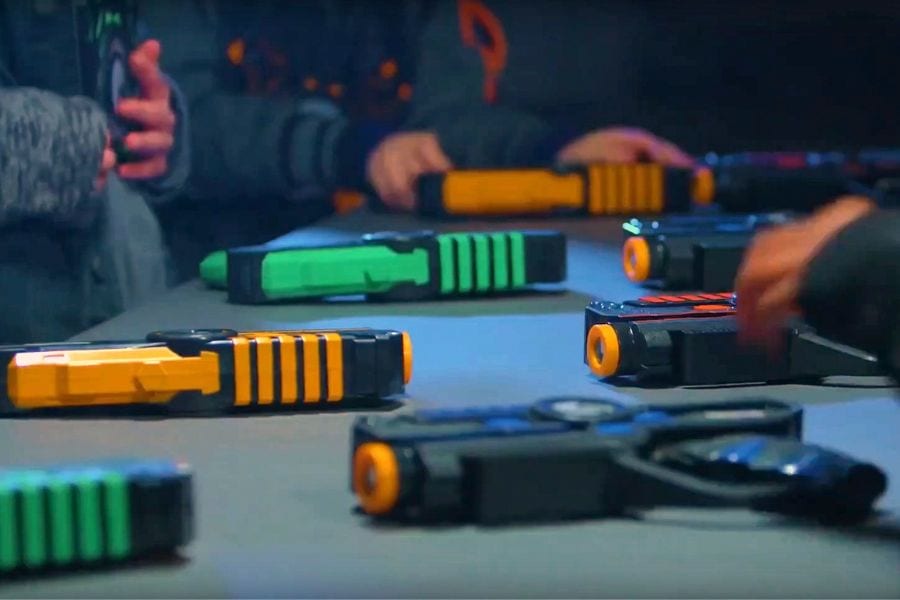
Step 2: Set Up The DIY Playing Area
Choose a space at your home that’s large enough to accommodate all players and offers a variety of hiding spots: outdoor or indoor, like a backyard or basement. While the indoor setting is more customizable, outdoor laser tag is more adventurous- choose according to your preference.
Make sure the area is free of hazards and well-lit enough to prevent hazards for kids. Also, keep aside the glass or porcelain materials. We often choose our basement to avoid cracks on any sensitive materials.
I set up obstacles using everyday items, such as upholstery, furniture, couches, tables, curtains, or cardboard to create blocks. I made some folding plywood walls with dark paint that looks like a temporary obstacle.
My sister created a folding ladder and a tree-like structure with curtains that could cover some players. To take it up a notch, I added some themed decorations, like glow-in-the-dark paint and LED lights.
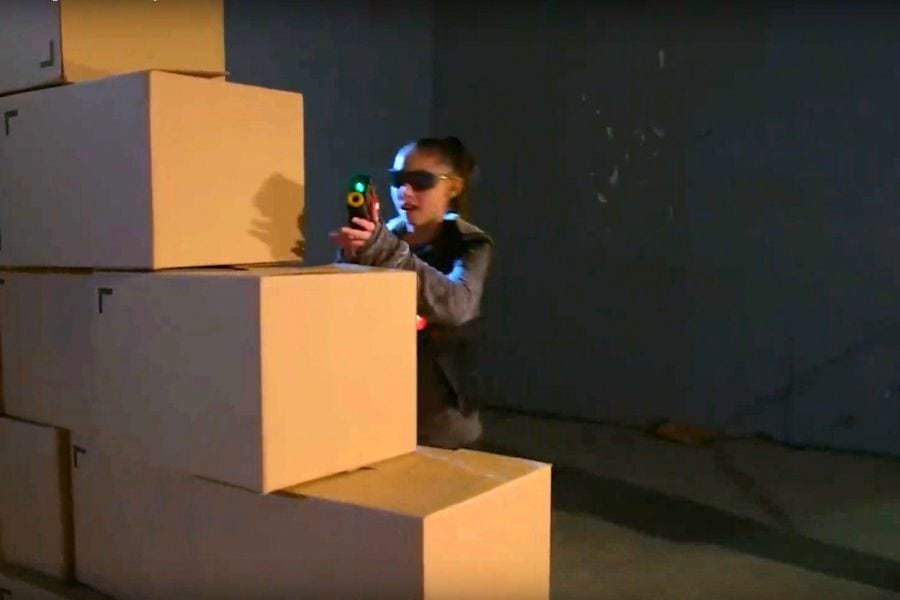
Step 3: Divide Players Into Teams
First decide, whether you are playing an individual mode or team-based goal. Assign teams if you’re playing a team-based game. For the team, you have to divide players into two sections and have each team start from a designated starting point at your home.
As an experienced laser tag player, I suggest creating well-balanced teams with a mix of skill levels to ensure a competitive and enjoyable party.
Step 4: Make And Explain The Rules
Make rules per your area, and set restrictions to protect ailing members or pet houses. Create guidelines for how players can eliminate their opponents. For example, tagging them with laser tag guns or using a designated hitting area on the opponent’s body.
Before starting the match, make sure everyone understands the basic rules, including how the equipment works, the objective of the rounds, and any specific rules you’d like to include. The objectives depend on the game modes like team elimination, capture the flag, or a timed match with the highest score at the end.
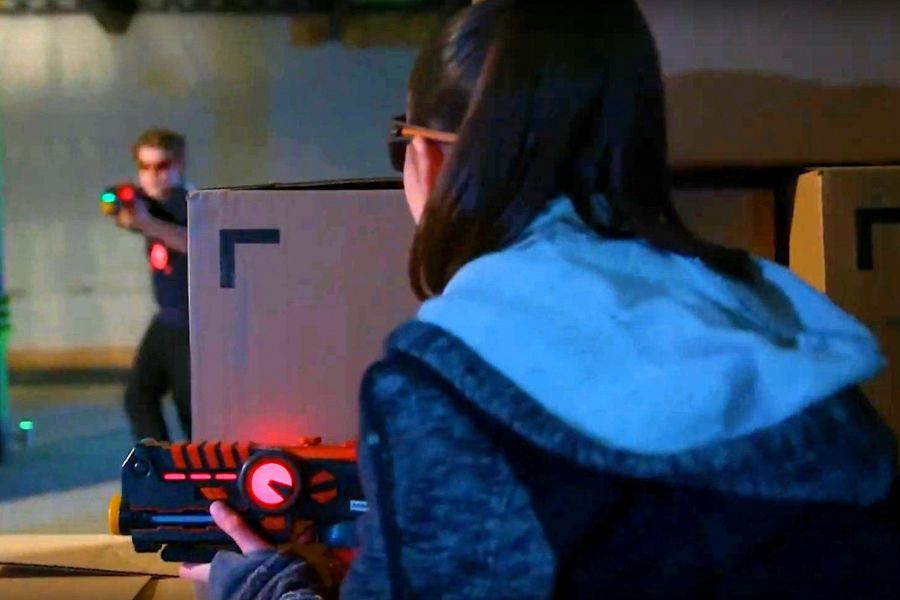
Step 5: Gear Up And Start The Game
Have each player put on their laser tag vest and choose their preferred weapon setting. Make sure everyone’s equipment is functioning correctly and synced with their team.
Once everyone is ready, gather the teams at their respective starting points, and begin the countdown. At the end of the designated time, the game begins, and players can start strategizing, attacking, and defending.
To keep things interesting, we play multiple rounds with different objectives or game variations. This allows players to experiment with different tactics, learn from their mistakes, and enjoy the thrill of competing for victory.
Most lasergame equipment automatically keeps track of individual and team scores. However, it’s a good idea to have a designated scorekeeper to ensure accuracy and resolve any disputes.

Step 6: Declare A Winner, Debrief And Improve
After the final round of home laser tag, tally the scores and declare a winning team. Celebrate with a small trophy or fun prizes for the victors, and don’t forget to acknowledge great sportsmanship and teamwork.
In the end, gather everyone together for a debrief session. Discuss what worked well, what didn’t, and what strategies led to success. This reflection helps players learn from their experiences and improve for future games.
Remember, the most important thing is to have fun and create lasting memories. By following this guide, you’ll be well on your way to hosting a thrilling and memorable laser tag event at home. Enjoy!
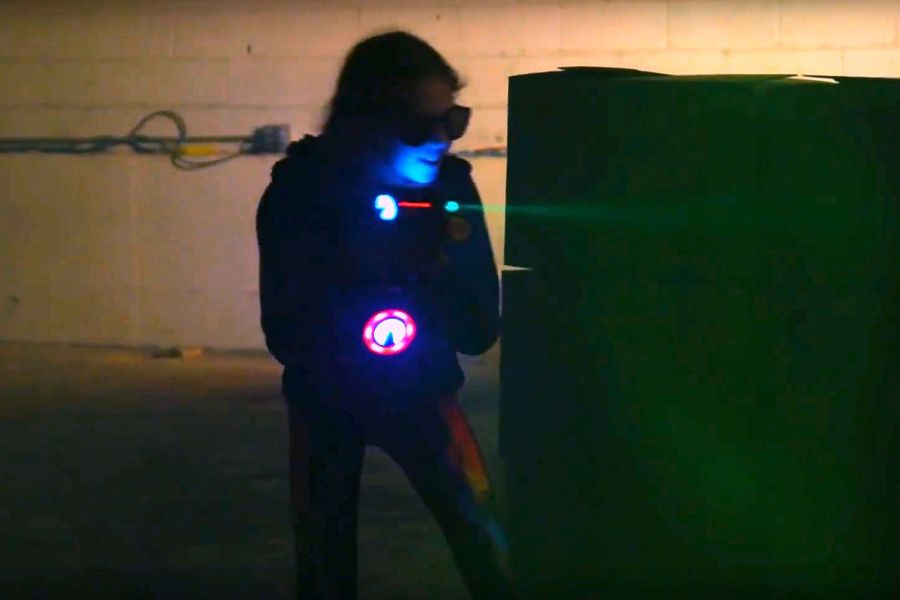
Creating An Indoor Laser Tag Arena At Home
When creating a laser tag arena in your home, it’s important to choose a suitable location. Based on my extensive experience, I recommend selecting a spacious area such as a basement, garage, or large room that is free of any potential hazards. Ensure that the space is clean and clear of any obstructions that could cause injuries.
Once you have a designated area, set up barriers and obstacles to make the game more fun and exciting. You can use common household items such as chairs, tables, and cardboard boxes or purchase inflatable bunkers to create a more tactical environment. By placing these barriers, you can create hiding spots and promote strategic gameplay. Here are some nice decorative items to make your arena more interesting.
To add more structure to the game, establish a base and respawn points for each team or player. These should be easily identifiable and well-protected, using colored flags or signs if necessary. In team-based matches, it’s also a good idea to designate additional respawn points throughout the arena.
Finally, to create a more immersive experience in home laser tag, adjust the lighting and ambiance in your indoor arena. Dim the lights or use colored and black lights to create a futuristic atmosphere- ideal for both kids and adults. You can also use glow-in-the-dark tape or paint to mark pathways, obstacles, and bases. You can be more creative with some cardboard boxes, paint them, and create your own DIY arrangements to make each round unique.

Laser Tag Game Modes That You Can Play At Your House
One of the great things about playing laser quest at your apartment is that you have the flexibility to create a unique setting that you may not find at a commercial arena. Here are some laser tag game modes that you can play specifically at your residence:
Hide and Seek: It involves one player hiding while the other players try to find and tag them. Once the hiding player is tagged, the roles switch and the player who found them becomes the new hider.
Protect the Home Base: In this game mode, one team defends a designated “home base” while the other team tries to invade and take it over. The defending team must eliminate all the attackers before they can take over the base.
Spy Hunt: Here, one player is designated as the “spy,” and the other players must try to eliminate them. The twist is that the spy has to avoid getting hit for a certain duration of time while trying to tag as many players as possible.
Last Man Standing: This is inspired by the popular video game genre. Players start in different parts of the arena and must eliminate each other until there is only one player left standing.
Protect the VIP: In this mode, one player is designated as the VIP, and the other players must protect them while trying to eliminate the opposing team’s VIP. The team that successfully protects their VIP or eliminates the opposing team’s VIP wins. We usually assign our grandpa and granny as VIPs, haha!
These are just a few examples of the many laser tag game modes that you can play exclusively at home. Get creative and have fun experimenting with different settings to keep your experience fresh and exciting.
Also Read: Can You Play Laser Tag During Pregnancy?
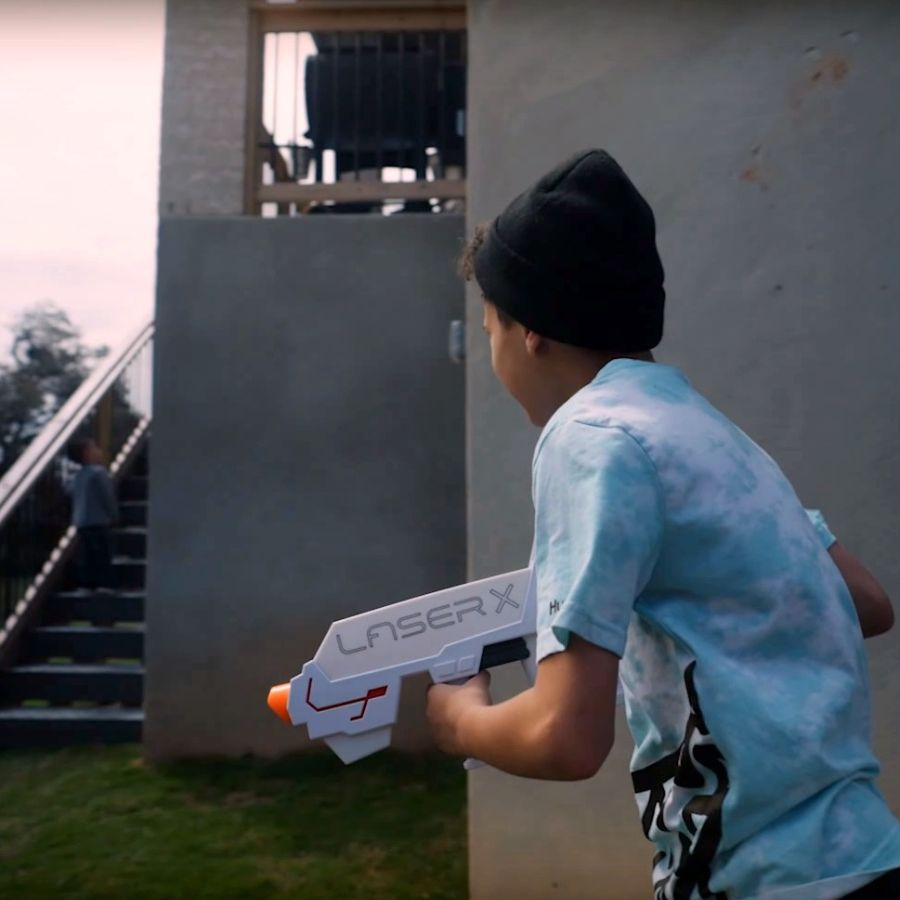
Pros And Cons Of Playing Home Laser Tag
PROS
More Convenient: You can play laser tag in the comfort of your own residence, without having to go to a dedicated arena or park.
Cost-effective: It can be more affordable in the long run than paying for repeated trips to a commercial venue.
Customizable: You can customize your own DIY setup, choosing the number of players, the layout of the play area, and the game rules to suit your preferences.
Familiar Environment: Playing laser skirmish at home means you and your friends or family are playing in a familiar environment, which can help you feel more comfortable and relaxed.
More Privacy: Unlike in a public laser tag arena, you can play with just your friends or siblings when playing in your backyard. This provides a sense of privacy and security, as you don’t have to worry about strangers.
Family Get-Together: It can be a fun family game night activity that encourages interaction and bonding. It provides an opportunity for family members to spend quality time together, work as a team, and enjoy a shared experience.
CONS
Limited Space: Unless you have a large indoor or outdoor area to play in, you may be restricted in terms of the size and complexity of the game.
Lack Of Variety: Since you only have access to one playing area, it can become repetitive over time. You may need to get creative with rules or change up the layout to make things interesting.
Limited Number Of Players: Depending on the size of your playing area and the number of laser guns and family members you have, you may be limited in the number of players who can participate.
Equipment Requirements: You need to purchase or rent suitable laser toy equipment, such as guns and vests, which can be expensive.
Also Read: Laser Tag or Nerf Guns: Which is Better for Home?
Conclusion
In a nutshell, playing home laser tag can be a great way to bond with friends and family and get some exercise in the process. By following the tips outlined in this article, you can create a fun environment in your own backyard, garden, lawn, or even inside your house.
Remember to choose a suitable lasergame set for your needs and set up your playing area with safety in mind. Be sure to establish rules and boundaries before starting the game and communicate with your teammates throughout the match. With a bit of preparation and practice, you can become a pro in no time.
So squad up and take your experience into the new world of your home— enjoy the complete family game in your DIY laser tag arena!

